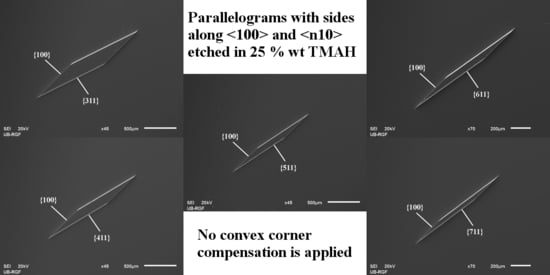Etching of Uncompensated Convex Corners with Sides along <n10> and <100> in 25 wt% TMAH at 80 °C
Abstract
1. Introduction
2. Experimental Setup
3. Simulation Method
4. Results and Discussion
5. Conclusions
Author Contributions
Funding
Conflicts of Interest
References
- Gosalvez, M.A.; Zubel, I.; Viinikka, E. Wet Etching of Silicon. In Handbook of Silicon Based MEMS Materials and Technologies; Lindroos, V., Tilli, M., Lehto, A., Motooka, T., Eds.; William Andrew, Elsevier: Norwich, NY, USA, 2010; Available online: https://www.elsevier.com/books/handbook-of-silicon-based-mems-materials-and-technologies/tilli/978-0-8155-1594-4 (accessed on 15 March 2019).
- Frühauf, J. Shape and Functional Elements of the Bulk Silicon Microtechnique; Springer: Berlin, Germary, 2005; Available online: http://www.springer.com/gp/book/9783540221098 (accessed on 15 March 2019).
- Shikida, M.; Sato, K.; Tokoro, K.; Uchikawa, D. Differences in anisotropic etching properties of KOH and TMAH solutions. Sens. Actuat. A 2000, 80, 179–188. [Google Scholar] [CrossRef]
- Sato, K.; Shikida, M.; Yamashiro, T.; Asaumi, K.; Iriye, Y.; Yamamoto, M. Anisotropic etching rates of single-crystal silicon for TMAH water solution as a function of crystallographic orientation. Sens. Actuat. A 1999, 73, 131–137. [Google Scholar] [CrossRef]
- Resnik, D.; Vrtacnik, D.; Aljancic, U.; Amon, S. Wet etching of silicon structures bounded by (311) sidewalls. Microelectron. Eng. 2000, 51, 555–566. [Google Scholar] [CrossRef]
- Resnik, D.; Vrtacnik, D.; Amon, S. Morphological study of {311} crystal planes anisotropically etched in (100) silicon: Role of etchants and etching parameters. J. Micromech. Microeng. 2000, 10, 430–439. [Google Scholar] [CrossRef]
- Yang, H.; Bao, M.; Shen, S.; Li, X.; Zhang, D.; Wu, G. A novel technique for measuring etch rate distribution of Si. Sens. Actuat. A 2000, 79, 136–140. [Google Scholar] [CrossRef]
- Landsberger, L.M.; Naseh, S.; Kahrizi, M.; Paranjape, M. On hillocks generated during anisotropic etching of Si in TMAH. IEEE J. Microelectromech. Syst. 1996, 5, 106–116. [Google Scholar] [CrossRef]
- Zubel, I.; Barycka, I.; Kotowska, K.; Kramkowska, M. Silicon anisotropic etching in alkaline solution IV: The effect of organic and inorganic agents on silicon anisotropic etching process. Sens. Actuat. A 2001, 87, 163–171. [Google Scholar] [CrossRef]
- Zubel, I. Anisotropic etching of Si. J. Micromech. Microeng. 2019, 29, 093002. [Google Scholar] [CrossRef]
- Shen, J.; Chen, Y.; Zhang, F.; Zhang, D.; Gan, Y. Morphological and crystallographic evolution of patterned silicon substrate etched in TMAH solutions. App. Surf. Sci. 2019, 496, 143720. [Google Scholar] [CrossRef]
- Trieu, H.K.; Mokwa, W. A generalized model describing corner undercutting by the experimental analysis of TMAH/IPA. J. Micromech. Microeng. 1998, 8, 80–83. [Google Scholar] [CrossRef]
- Sarro, P.M.; Brida, D.; Vlist, W.V.D.; Brida, S. Effect of surfactant on surface quality of silicon microstructures etched in saturated TMAHW solutions. Sens. Actuat. A 2000, 85, 340–345. Available online: https://www.sciencedirect.com/science/article/pii/S0924424700003174 (accessed on 15 March 2019). [CrossRef]
- Smiljanić, M.M.; Jović, V.; Lazić, Ž. Maskless convex corner compensation technique on a (1 0 0) silicon substrate in a 25 wt% TMAH water solution. J. Micromech. Microeng. 2012, 22, 115011. [Google Scholar] [CrossRef]
- Smiljanić, M.M.; Radjenović, B.; Radmilović-Radjenović, M.; Lazić, Ž.; Jović, V. Simulation and experimental study of maskless convex corner compensation in TMAH water solution. J. Micromech. Microeng. 2014, 24, 115003. [Google Scholar] [CrossRef]
- Mukhiya, R.; Bagolini, A.; Margesin, B.; Zen, M.; Kal, S. <100> bar corner compensation for CMOS compatible anisotropic TMAH etching. J. Micromech. Microeng. 2006, 16, 2458–2462. [Google Scholar] [CrossRef]
- Bagolini, A.; Faes, A.; Decarli, M. Influence of Etching Potential on Convex Corner Anisotropic Etching in TMAH Solution. IEEE J. Microelectromech. Syst. 2010, 19, 1254–1259. [Google Scholar] [CrossRef]
- Mukhiya, R.; Bagolini, A.; Bhattacharyya, T.K.; Lorenzelli, L.; Zen, M. Experimental study and analysis of corner compensation structures for CMOS compatible bulk micromachining using 25 wt% TMAH. Microelectron. J. 2011, 42, 127–134. [Google Scholar] [CrossRef]
- Merlos, A.; Acero, M.C.; Bao, M.H.; Bausells, J.; Esteve, J. A study of the undercutting characteristics in the TMAH-IPA system. J. Micromech. Microeng. 1992, 2, 181–183. [Google Scholar] [CrossRef]
- Merlos, A.; Acero, M.C.; Bao, M.H.; Bausells, J.; Esteve, J. TMAH/IPA anisotropic etching characteristics. Sens. Actuat. A 1993, 37, 737–743. [Google Scholar] [CrossRef]
- Pal, P.; Sato, K.; Shikida, M.; Gosalvez, M.A. Study of corner compensating structures and fabrication of various shape of MEMS structures in pure and surfactant added TMAH. Sens. Actuat. A 2009, 154, 192–203. [Google Scholar] [CrossRef]
- Pal, P.; Sato, K.; Chandra, S. Fabrication techniques of convex corners in a (100)-silicon wafer using bulk micromachining: A review. J. Micromech. Microeng. 2007, 17, R111. [Google Scholar] [CrossRef]
- Powell, O.; Harrison, H.B. Anisotropic etching of {100} and {110} planes in (100) silicon. J. Micromech. Microeng. 2001, 11, 217–220. [Google Scholar] [CrossRef]
- Pal, P.; Sato, K. A comprehensive review on convex and concave corners in silicon bulk micromachining based on anisotropic wet chemical etching. Micro. Nano. Syst. Lett. 2015, 3, 1–42. [Google Scholar] [CrossRef]
- Pal, P.; Haldar, S.; Singh, S.S.; Ashok, A.; Yan, X.; Sato, K. A detailed investigation and explanation to the appearance of different undercut profiles in KOH and TMAH. J. Micromech. Microeng. 2014, 24, 095026. [Google Scholar] [CrossRef]
- Pal, P.; Sato, K.; Gosalvez, M.A.; Shikida, M. Study of rounded concave and sharp edge convex corners undercutting in CMOS compatible anisotropic etchants. J. Micromech. Microeng. 2007, 17, 2299–2307. [Google Scholar] [CrossRef]
- Smiljanić, M.M.; Radjenović, B.; Radmilović-Radjenović, M.; Lazić, Ž.; Jović, V. Evolution of Si crystallographic planes-etching of square and circle patterns in 25 wt% TMAH. Micromachines 2019, 10, 102. [Google Scholar] [CrossRef]
- Pal, P.; Gosalvez, M.A.; Sato, K.; Hida, H.; Xing, Y. Anisotropic etching on Si{1 1 0}: Experiment and simulation for the formation of microstructures with convex corners. J. Micromech. Microeng. 2014, 24, 125001. [Google Scholar] [CrossRef]
- Smiljanić, M.M.; Lazić, Ž; Radjenović, B.; Radmilović-Radjenović, M.; Jović, V.; Rašljić, M.; Cvetanović, K.; Filipović, A. Etched Parallelogram Patterns with Sides Along <100> and <n10> Directions in 25 wt% TMAH. In Proceedings of the 6th Conference IcETRAN, Srebrno jezero, Serbia, 3–6 June 2019. [Google Scholar]
- Gosalvez, M.A.; Sato, K.; Foster, A.S.; Nieminenn, R.M.; Tanaka, H. An atomistic introduction to anisotropic etching. J. Micromech. Microeng. 2007, 17, S1–S26. [Google Scholar] [CrossRef]
- Montoliu, C.; Ferrando, N.; Gosalvez, M.A.; Cerda, J.; Colom, R.J. Level set implementation for the simulation of anisotropic etching: Application to complex MEMS micromachining. J. Micromech. Microeng. 2013, 23, 075017. [Google Scholar] [CrossRef]
- Montoliu, C.; Ferrando, N.; Gosalvez, M.A.; Cerda, J.; Colom, R.J. Implementation and evaluation of the Level Set method–Towards efficient and accurate simulation of wet etching for microengineering applications. Comput. Phys. Commun. 2013, 184, 2299–2309. [Google Scholar] [CrossRef]
- Yu, J.C.; Zhou, Z.F.; Su, J.L.; Xia, C.F.; Zhang, X.W.; Wu, Z.Z.; Huang, Q.A. Three-Dimensional Simulation of DRIE Process Based on the Narrow Band Level Set and Monte Carlo Method. Micromachines 2018, 9, 74. [Google Scholar] [CrossRef]
- Hubbard, T.J. MEMS Design-Geometry of Silicon Micromachining. Ph.D. Thesis, California Institute of Technology, Pasadena, CA, USA, April 1994. Available online: https://thesis.library.caltech.edu/3565/1/Hubbard_tj_1994.pdf (accessed on 15 March 2019).
- Osher, S.; Sethian, J.A. Fronts Propagating with Curvature Dependent Speed: Algorithms Based on Hamilton-Jacobi Formulations. J. Comp. Phys. 1988, 79, 12–49. [Google Scholar] [CrossRef]
- Radjenović, B.; Lee, J.K.; Radmilović-Radjenović, M. Sparse field level set method for non-convex Hamiltonians in 3D plasma etching profile simulations. Comput. Phy. Commun. 2006, 174, 127–132. [Google Scholar] [CrossRef]
- Radjenović, B.; Radmilović-Radjenović, M.; Mitrić, M. Non-convex Hamiltonians in 3D level set simulations of the wet etching of silicon. Appl. Phys. Lett. 2006, 89, 213102. [Google Scholar] [CrossRef]
- Radjenović, B.; Radmilović-Radjenović, M. 3D simulations of the profile evolution during anisotropic wet etching of silicon. Thin Solid Film. 2009, 517, 4233–4237. [Google Scholar] [CrossRef]
- Radjenović, B.; Radmilović-Radjenović, M.; Mitrić, M. Level Set Approach to Anisotropic Wet Etching of Silicon. Sensors 2010, 10, 4950–4967. [Google Scholar] [CrossRef]
- Bernacka-Wojcik, I.; Ribiero, S.; Wojcik, P.J.; Alves, P.U.; Busani, T.; Fortunato, E.; Viana Baptista, P.; Covas, J.A.; Águas, H.; Hilliou, L.; et al. Experimental optimization of a passive planar rhombic micromixer with obstacles for effective mixing in a short channel length. RSC Adv. 2014, 4, 56013–56025. [Google Scholar] [CrossRef]
- Alves, P.U.; Vinhas, R.; Fernandes, A.R.; Birol, S.Z.; Trabzon, L.; Bernacka-Wojcik, I.; Igreja, R.; Lopes, P.; Viana Baptista, P.; Águas, H.; et al. Multifunctional microfluidic chip for optical nanoprobe based RNA detection–application to Chronic Myeloid Leukemia. Sci. Rep. 2018, 8, 381. [Google Scholar] [CrossRef]
- Wang, H.; Iovenitti, P.; Harvey, E.; Masood, S. Optimizing layout of obstacles for enhanced mixing in microchannels. Smart Mater. Struct. 2002, 11, 662–667. [Google Scholar] [CrossRef]
- Bhagat, A.A.S.; Peterson, E.T.K.; Papautsky, I. A passive planar micromixer with obstructions for mixing at low Reynolds numbers. J. Micromech. Microeng. 2007, 17, 1017–1024. [Google Scholar] [CrossRef]
- Wang, C.T.; Hu, Y.C. Mixing of liquids using obstacles in Y-type microchannels. Tamkang J. Sci. Eng. 2010, 13, 385–394. [Google Scholar]
- Jeon, W.; Burm Shin, C. Design and simulation of passive mixing in microfluidic systems with geometric variation. Chem. Eng. J. 2009, 152, 575–582. [Google Scholar] [CrossRef]
- McGrath, J.; Jimenez, M.; Bridle, H. Deterministic lateral displacement for particle separation: A review. Lab. Chip 2014, 4, 4139. [Google Scholar] [CrossRef] [PubMed]
- Zhang, Z.; Chien, W.; Henry, E.; Fedosov, D.A.; Gompper, G. Sharp-edged geometric obstacles in microfluidics promote deformability-based sorting of cells. Phys. Rev. Fluid. 2019, 4, 024201. [Google Scholar] [CrossRef]
- Guo, Q.; Duffy, S.P.; Matthews, K.; Islamzada, E.; Ma, H. Deformability based cell sorting using microfluidic ratchets enabling phenotypic separation of leukocytes directly from whole blood. Sci. Rep. 2017, 7, 6627. [Google Scholar] [CrossRef] [PubMed]
- Jiang, J.; Zhao, H.; Shu, W.; Tian, J.; Huang, Y.; Song, Y.; Wang, R.; Li, E.; Slamon, D.; Hou, D.; et al. An integrated microfluidic devices for rapid and high-sensitivity analysis of circulating tumor cells. Sci. Rep. 2017, 7, 42612. [Google Scholar] [CrossRef] [PubMed]
- Lykov, K.; Nematbakhsh, Y.; Shang, M.; Lim, C.T.; Pivkin, I.V. Probing eukaryotic cell mechanics via mesoscopic simulations. PLoS Comput. Biol. 2017, 13, e1005726. [Google Scholar] [CrossRef] [PubMed]
- Feng, J.; Rothstein, J.P. One-way wicking in open micro-channels controlled by channel topography. J. Colloid Interf. Sci. 2013, 404, 169–178. [Google Scholar] [CrossRef]
- Sethian, J. Level Set Methods and Fast Marching Methods: Evolving Inter. faces in Computational Fluid Mechanics; Computer Vision and Materials Sciences; Cambridge University Press: Cambridge, UK, 1998. [Google Scholar]
- Osher, S.; Fedkiw, R. Level Set Method and Dynamic Implicit Surfaces; Springer: New York, NY, USA, 2002; Available online: https://www.springer.com/gp/book/9780387954820 (accessed on 15 March 2019).
- Whitaker, R. A level-set approach to 3D reconstruction from range data. Int. J. Comput. Vision 1998, 29, 203–231. [Google Scholar] [CrossRef]
- NLM Insight Segmentation and Registration Toolkit. Available online: www.itk.org (accessed on 15 March 2019).
- Alsina, C.; Nelsen, R.B. A Mathematical Space Odyssey: Solid Geometry in the 21st Century; The Mathematical Association of America: Washington, WA, USA, 2015; pp. 85–89. Available online: https://www.maa.org/press/books/a-mathematical-space-odyssey-solid-geometry-in-the-21st-century (accessed on 15 March 2019).
- ParaView. Available online: http://www.paraview.org/ (accessed on 15 March 2019).
- Roh, C.; Lee, J.; Kang, C.K. Physical properties of PDMS (polydimethylsiloxane) microfluidic devices on fluid behaviors: Various diameters and shapes of periodically-embedded microstructures. Materials 2016, 9, 836. [Google Scholar] [CrossRef]
- Kang, C.K.; Roh, C.; Overfelt, R.A. Pressure-driven deformation with soft polydimethylsiloxane (PDMS) by a regular syringe pump: Challenge to the classical fluid dynamics by comparison of experimental and theoretical results. RSC Adv. 2013, 4, 3102–3112. [Google Scholar] [CrossRef]
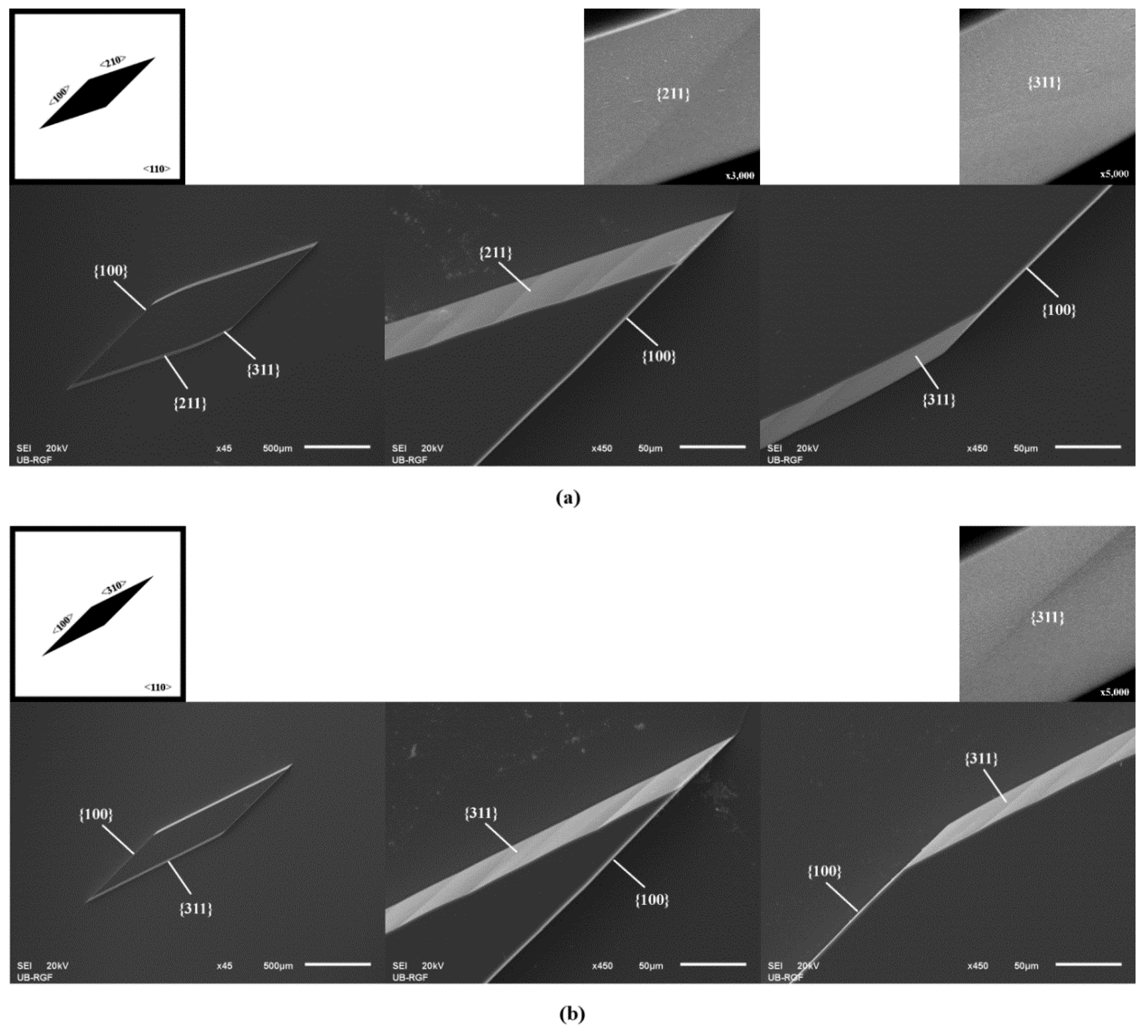
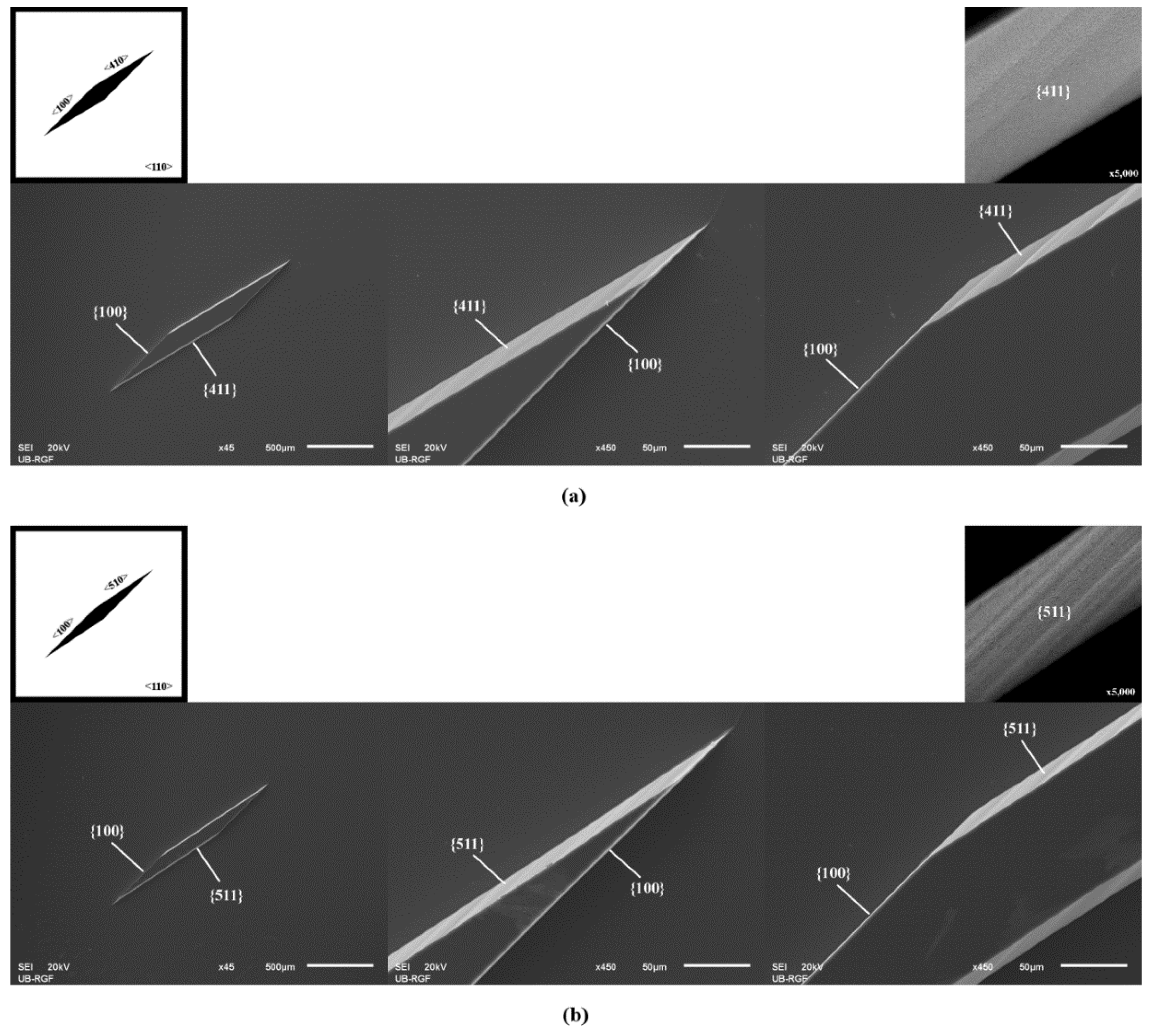
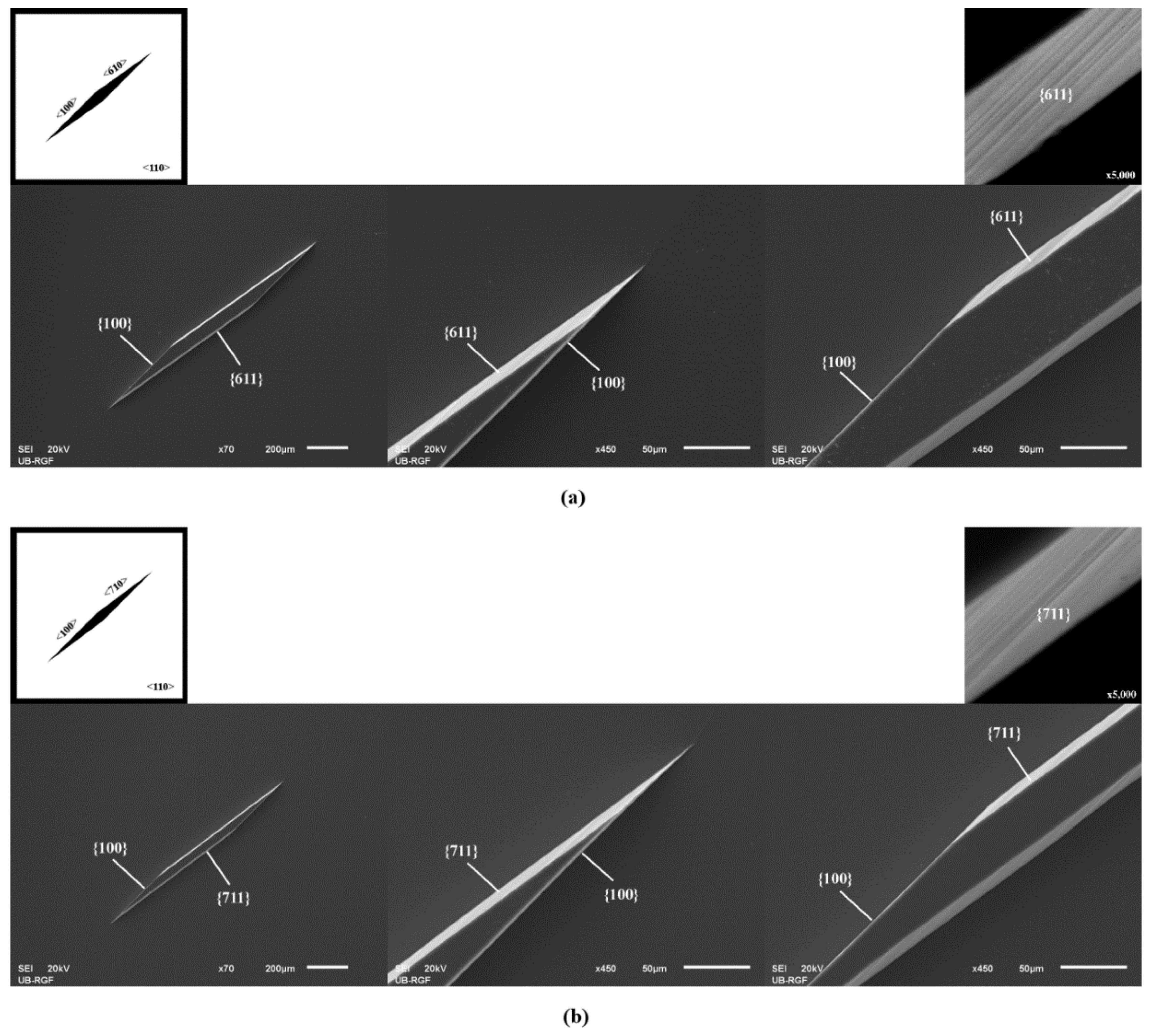
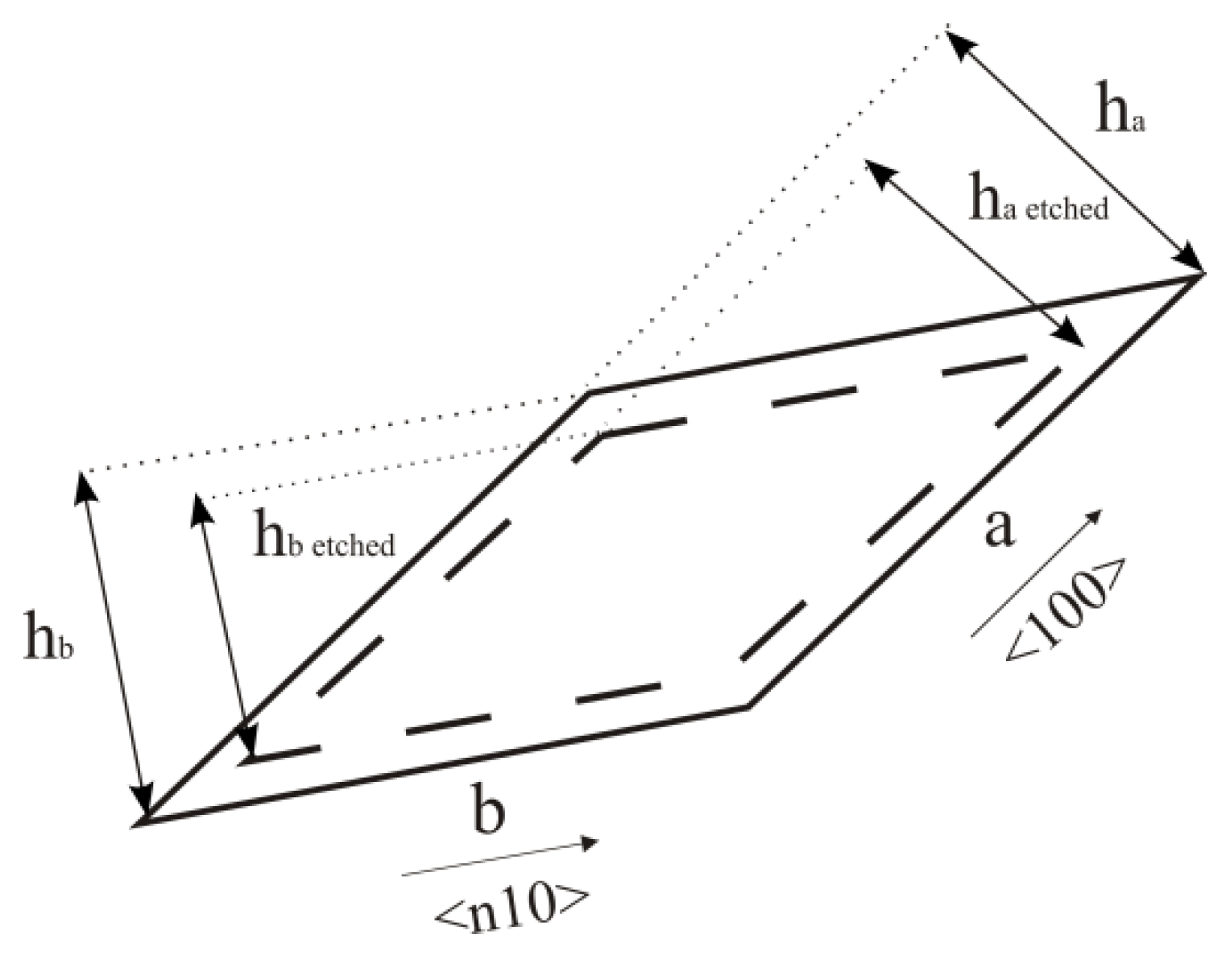
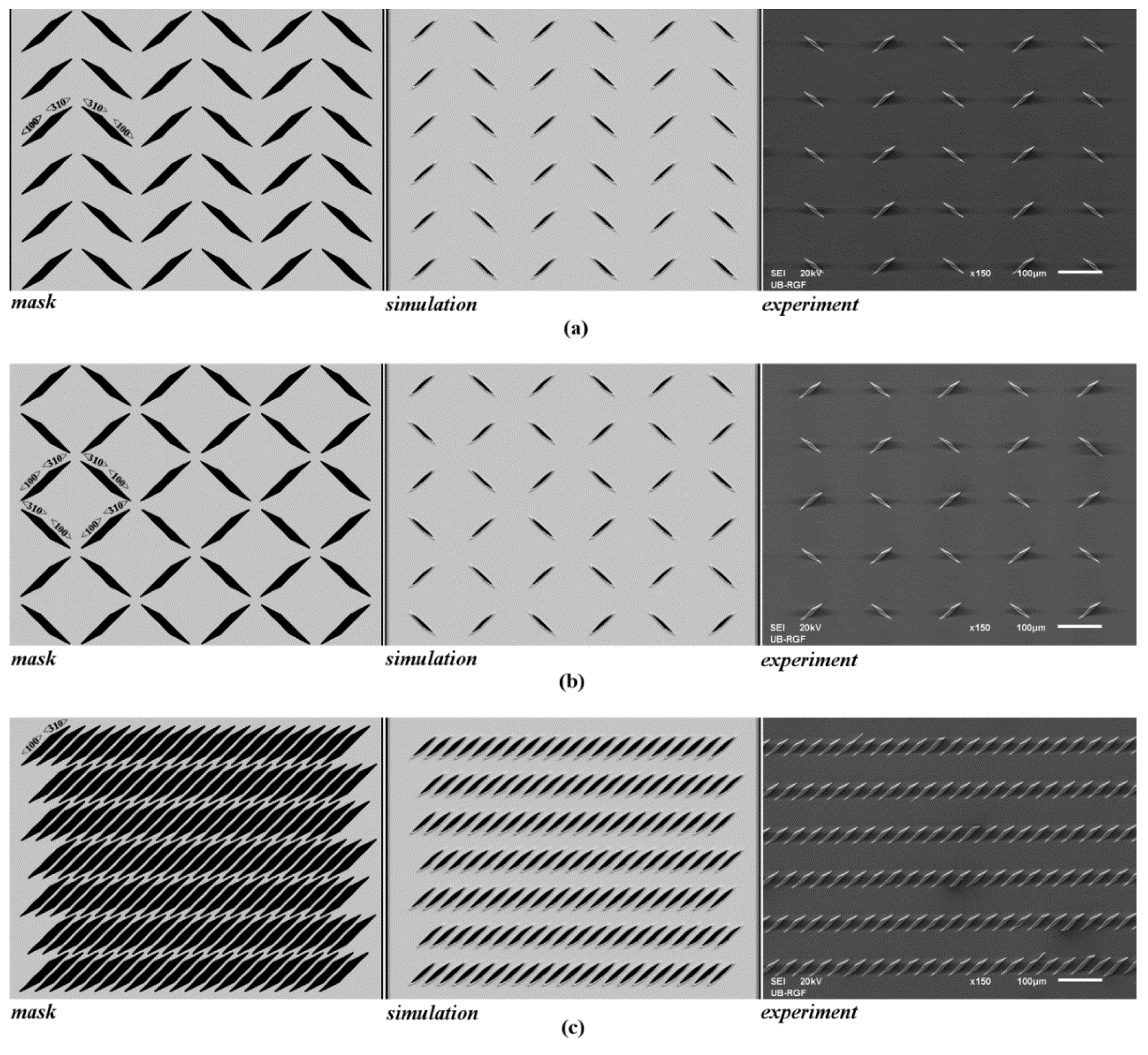
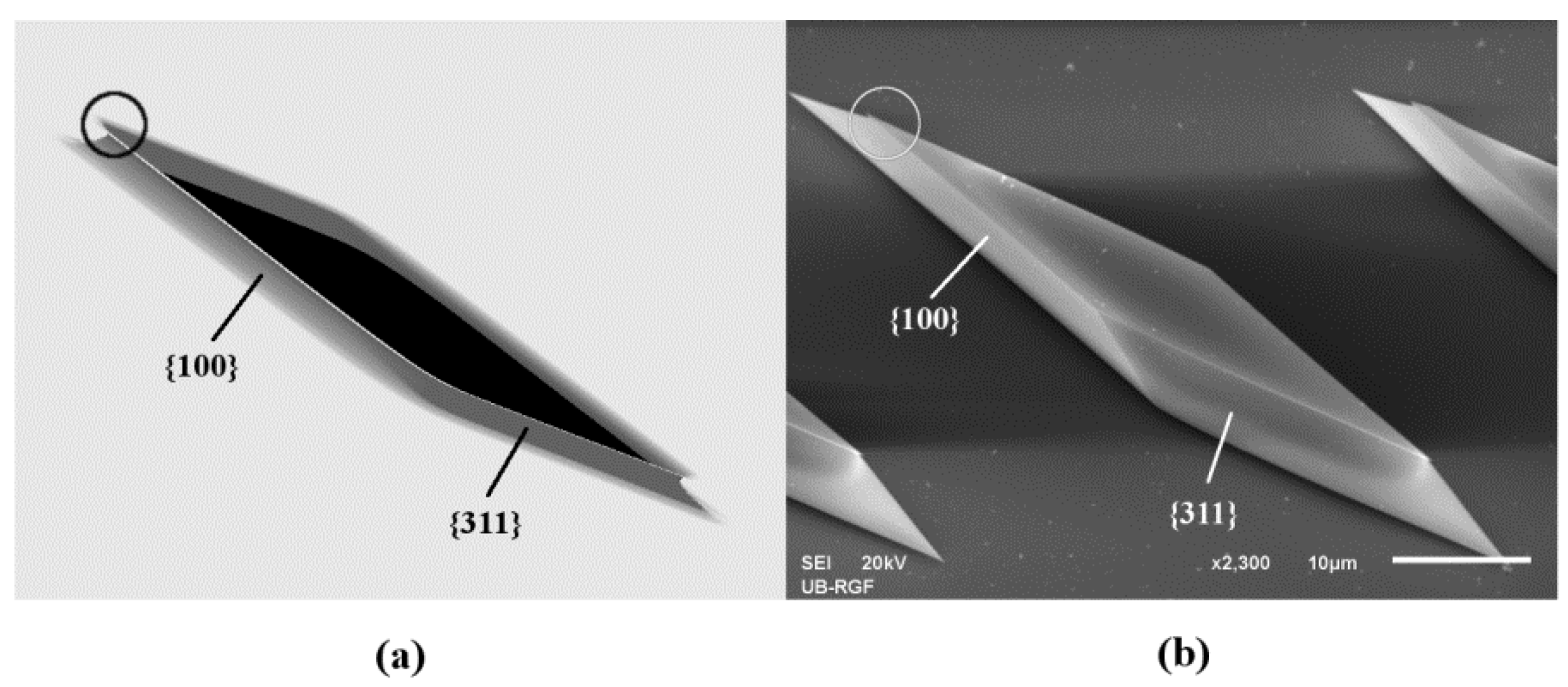
| Crystallographic Direction <n10> | Acute Angle [°] | Obtuse Angle [°] |
|---|---|---|
| <210> | 26.6 | 153.4 |
| <310> | 18.4 | 161.6 |
| <410> | 14 | 166 |
| <510> | 11.3 | 168.7 |
| <610> | 9.5 | 170.5 |
| Crystallographic Plane {n11} | Angle γn11 Theoretical [°] | Angle γn11 [27] [°] |
|---|---|---|
| <211> | 65.9 | 66.7 |
| <311> | 72.5 | 74.2 |
| <411> | 76.4 | 78.7 |
| <511> | 78.9 | 80.9 |
| <611> | 80.7 | 81 |
| Crystallographic plane {n11} | Etch Rates rn11 [27] [µm/min] | Un11 |
|---|---|---|
| <211> | 0.87 | 2.06 |
| <311> | 0.93 | 2.10 |
| <411> | 0.85 | 1.89 |
| <511> | 0.81 | 1.78 |
| <611> | 0.73 | 1.61 |
| <711> | 0.69 | 1.52 |
© 2020 by the authors. Licensee MDPI, Basel, Switzerland. This article is an open access article distributed under the terms and conditions of the Creative Commons Attribution (CC BY) license (http://creativecommons.org/licenses/by/4.0/).
Share and Cite
Smiljanić, M.M.; Lazić, Ž.; Jović, V.; Radjenović, B.; Radmilović-Radjenović, M. Etching of Uncompensated Convex Corners with Sides along <n10> and <100> in 25 wt% TMAH at 80 °C. Micromachines 2020, 11, 253. https://doi.org/10.3390/mi11030253
Smiljanić MM, Lazić Ž, Jović V, Radjenović B, Radmilović-Radjenović M. Etching of Uncompensated Convex Corners with Sides along <n10> and <100> in 25 wt% TMAH at 80 °C. Micromachines. 2020; 11(3):253. https://doi.org/10.3390/mi11030253
Chicago/Turabian StyleSmiljanić, Milče M., Žarko Lazić, Vesna Jović, Branislav Radjenović, and Marija Radmilović-Radjenović. 2020. "Etching of Uncompensated Convex Corners with Sides along <n10> and <100> in 25 wt% TMAH at 80 °C" Micromachines 11, no. 3: 253. https://doi.org/10.3390/mi11030253
APA StyleSmiljanić, M. M., Lazić, Ž., Jović, V., Radjenović, B., & Radmilović-Radjenović, M. (2020). Etching of Uncompensated Convex Corners with Sides along <n10> and <100> in 25 wt% TMAH at 80 °C. Micromachines, 11(3), 253. https://doi.org/10.3390/mi11030253




